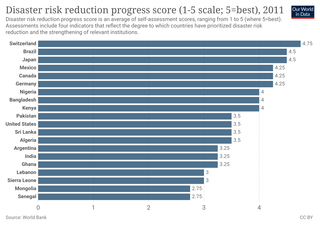The precautionary principle is a broad epistemological, philosophical and legal approach to innovations with potential for causing harm when extensive scientific knowledge on the matter is lacking. It emphasizes caution, pausing and review before leaping into new innovations that may prove disastrous. Critics argue that it is vague, self-cancelling, unscientific and an obstacle to progress.
Risk assessment determines possible mishaps, their likelihood and consequences, and the tolerances for such events. The results of this process may be expressed in a quantitative or qualitative fashion. Risk assessment is an inherent part of a broader risk management strategy to help reduce any potential risk-related consequences.

A crisis is any event or period that will lead to an unstable and dangerous situation affecting an individual, group, or all of society. Crises are negative changes in the human or environmental affairs, especially when they occur abruptly, with little or no warning. More loosely, a crisis is a testing time for an emergency.

The International Risk Governance Center (IRGC) is a neutral interdisciplinary center based at the École Polytechnique Fédérale de Lausanne (EPFL) in Lausanne, Switzerland. IRGC develops risk governance strategies that focus on involving all key stakeholder groups, including citizens, governments, businesses and academia. It exists to improve the understanding, management and governance of emerging and systemic risks that may have significant adverse consequences for human health and the environment, the economy and society. Its mission includes "developing concepts of risk governance, anticipating major risk issues and providing risk governance policy advice for key decision-makers."
The cultural theory of risk, often referred to simply as Cultural Theory, consists of a conceptual framework and an associated body of empirical studies that seek to explain societal conflict over risk. Whereas other theories of risk perception stress economic and cognitive influences, Cultural Theory asserts that structures of social organization endow individuals with perceptions that reinforce those structures in competition against alternative ones. This theory was first elaborated in the book Natural Symbols, written by anthropologist Mary Douglas in 1970. Douglas later worked closely with the political scientist Aaron Wildavsky, to clarify the theory. Cultural Theory has given rise to a diverse set of research programs that span multiple social science disciplines and that have in recent years been used to analyze policymaking conflicts generally.

Risk perception is the subjective judgement that people make about the characteristics and severity of a risk. Risk perceptions often differ from statistical assessments of risk since they are affected by a wide range of affective, cognitive, contextual, and individual factors. Several theories have been proposed to explain why different people make different estimates of the dangerousness of risks. Three major families of theory have been developed: psychology approaches, anthropology/sociology approaches and interdisciplinary approaches.
Frame analysis is a multi-disciplinary social science research method used to analyze how people understand situations and activities. Frame analysis looks at images, stereotypes, metaphors, actors, messages, and more. It examines how important these factors are and how and why they are chosen. The concept is generally attributed to the work of Erving Goffman and his 1974 book Frame analysis: An essay on the organization of experience and has been developed in social movement theory, policy studies and elsewhere.
Psycho-oncology is an interdisciplinary field at the intersection of physical, psychological, social, and behavioral aspects of the cancer experience for both patients and caregivers. Also known as psychiatric oncology or psychosocial oncology, researchers and practitioners in the field are concerned with aspects of individuals' experience with cancer beyond medical treatment, and across the cancer trajectory, including at diagnosis, during treatment, transitioning to and throughout survivorship, and approaching the end-of-life. Founded by Jimmie Holland in 1977 via the incorporation of a psychiatric service within the Memorial Sloan Kettering Cancer Center in New York, the field has expanded drastically since and is now universally recognized as an integral component of quality cancer care. Cancer centers in major academic medical centers across the country now uniformly incorporate a psycho-oncology service into their clinical care, and provide infrastructure to support research efforts to advance knowledge in the field.

Environmental communication is "the dissemination of information and the implementation of communication practices that are related to the environment. In the beginning, environmental communication was a narrow area of communication; however, nowadays, it is a broad field that includes research and practices regarding how different actors interact with regard to topics related to the environment and how cultural products influence society toward environmental issues".
In its broadest sense, social vulnerability is one dimension of vulnerability to multiple stressors and shocks, including abuse, social exclusion and natural hazards. Social vulnerability refers to the inability of people, organizations, and societies to withstand adverse impacts from multiple stressors to which they are exposed. These impacts are due in part to characteristics inherent in social interactions, institutions, and systems of cultural values.

Disaster risk reduction (DRR) is an approach for planning and taking steps to make disasters less likely to happen, and less damaging when they do happen. DRR aims to make communities stronger and better prepared to handle disasters. When DRR is successful, it decreases the vulnerability of communities because it mitigates the effects of disasters. This means DRR can reduce the severity and number of risky events. Since climate change can increase climate hazards, DRR and climate change adaptation are often looked at together in development efforts.
Problematic Integration Theory is a theory of communication that addresses the processes and dynamics of how people receive, evaluate, and respond to information and experiences. The premises of PI are based on the view that message processing, specifically the development of probabilistic and evaluative orientations, is a social and cultural construction. In situations where there is agreement between probabilistic orientation and evaluative orientation, integration is in harmony, i.e., not problematic. However, when there is disagreement between these orientations about an object, then integration becomes problematic. This disharmony leads to conflict and discomfort, which can manifest itself as cognitive, communicative, affective, and/or motivational.
Risk communication is a complex cross-disciplinary academic field that is part of risk management and related to fields like crisis communication. The goal is to make sure that targeted audiences understand how risks affect them or their communities by appealing to their values.

In simple terms, risk is the possibility of something bad happening. Risk involves uncertainty about the effects/implications of an activity with respect to something that humans value, often focusing on negative, undesirable consequences. Many different definitions have been proposed. The international standard definition of risk for common understanding in different applications is "effect of uncertainty on objectives".
In public policy, outrage factor is public opposition to a policy that is not based on the knowledge of the technical details. The term "outrage factor" originates from Peter Sandman's 1993 book, Responding to Community Outrage: Strategies for Effective Risk Communication.
Risk governance refers to the institutions, rules conventions, processes and mechanisms by which decisions about risks are taken and implemented. It can be both normative and positive, because it analyses and formulates risk management strategies to avoid and/or reduce the human and economic costs caused by disasters.

Interpersonal communication is an exchange of information between two or more people. It is also an area of research that seeks to understand how humans use verbal and nonverbal cues to accomplish several personal and relational goals. Communication includes utilizing communication skills within one's surroundings, including physical and psychological spaces. It is essential to see the visual/nonverbal and verbal cues regarding the physical spaces. In the psychological spaces, self-awareness and awareness of the emotions, cultures, and things that are not seen are also significant when communicating.
Vulnerability refers to "the quality or state of being exposed to the possibility of being attacked or harmed, either physically or emotionally." The understanding of social and environmental vulnerability, as a methodological approach, involves the analysis of the risks and assets of disadvantaged groups, such as the elderly. The approach of vulnerability in itself brings great expectations of social policy and gerontological planning. Types of vulnerability include social, cognitive, environmental, emotional or military.

Howard Charles Kunreuther was an American economist. He was the James G. Dinan professor emeritus of decision sciences and public policy at the Wharton School of the University of Pennsylvania.

C. Emdad Haque is a Canadian academic, environmentalist, and author. He is a professor in the Natural Resources Institute of the Clayton H. Riddell Faculty of Environment, Earth, and Resources at the University of Manitoba and Chief Technical Advisor at the Bangabandhu Centre of Bangladesh Studies in Canada.









